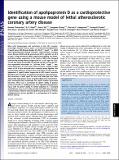Identification of apolipoprotein D as a cardioprotective gene using a mouse model of lethal atherosclerotic coronary artery disease
Author(s)
Mani, D. R.; Tsukamoto, Kosuke; Zhang, Songwen; Krieger, Monty; Shi, Jianru; Haagensen, Darrow E.; Otsuka, Fumiyuki; Guan, Jian; Smith, Jonathan D.; Weng, Wei; Liao, Ronglih; Kolodgie, Frank D.; Virmani, Renu; ... Show more Show less
DownloadPNAS-2013-Tsukamoto-17023-8.pdf (942.4Kb)
PUBLISHER_POLICY
Publisher Policy
Article is made available in accordance with the publisher's policy and may be subject to US copyright law. Please refer to the publisher's site for terms of use.
Terms of use
Metadata
Show full item recordAbstract
Mice with homozygous null mutations in the HDL receptor (scavenger receptor class B, type I, or SR-BI) and apolipoprotein E (apoE) genes [SR-BI/apoE double KO (SR-BI[superscript −/−]/apoE[superscript −/−] or dKO) mice] spontaneously develop occlusive, atherosclerotic coronary artery disease (CAD) and die prematurely (50% mortality at 42 d of age). Using microarray mRNA expression profiling, we identified genes whose expression in the hearts of dKO mice changed substantially during disease progression [at 21 d of age (no CAD), 31 d of age (small myocardial infarctions), and 43 d of age (extensive myocardial infarctions) vs. CAD-free SR-BI[superscript +/−]/apoE[superscript −/−] controls]. Expression of most genes that increased >sixfold in dKO hearts at 43 d also increased after coronary artery ligation. We examined the influence and potential mechanism of action of apolipoprotein D (apoD) whose expression in dKO hearts increased 80-fold by 43 d. Analysis of ischemia/reperfusion-induced myocardial infarction in both apoD KO mice and wild-type mice with abnormally high plasma levels of apoD (adenovirus-mediated hepatic overexpression) established that apoD reduces myocardial infarction. There was a correlation of apoD’s ability to protect primary cultured rat cardiomyocytes from hypoxia/reoxygenation injury with its potent ability to inhibit oxidation in a standard antioxidation assay in vitro. We conclude that dKO mice represent a useful mouse model of CAD and apoD may be part of an intrinsic cardioprotective system, possibly as a consequence of its antioxidation activity.
Date issued
2013-09Department
Massachusetts Institute of Technology. Department of BiologyJournal
Proceedings of the National Academy of Sciences
Publisher
National Academy of Sciences (U.S.)
Citation
Tsukamoto, K., D. R. Mani, J. Shi, S. Zhang, D. E. Haagensen, F. Otsuka, J. Guan, et al. “Identification of Apolipoprotein D as a Cardioprotective Gene Using a Mouse Model of Lethal Atherosclerotic Coronary Artery Disease.” Proceedings of the National Academy of Sciences 110, no. 42 (October 15, 2013): 17023–17028.
Version: Final published version
ISSN
0027-8424
1091-6490